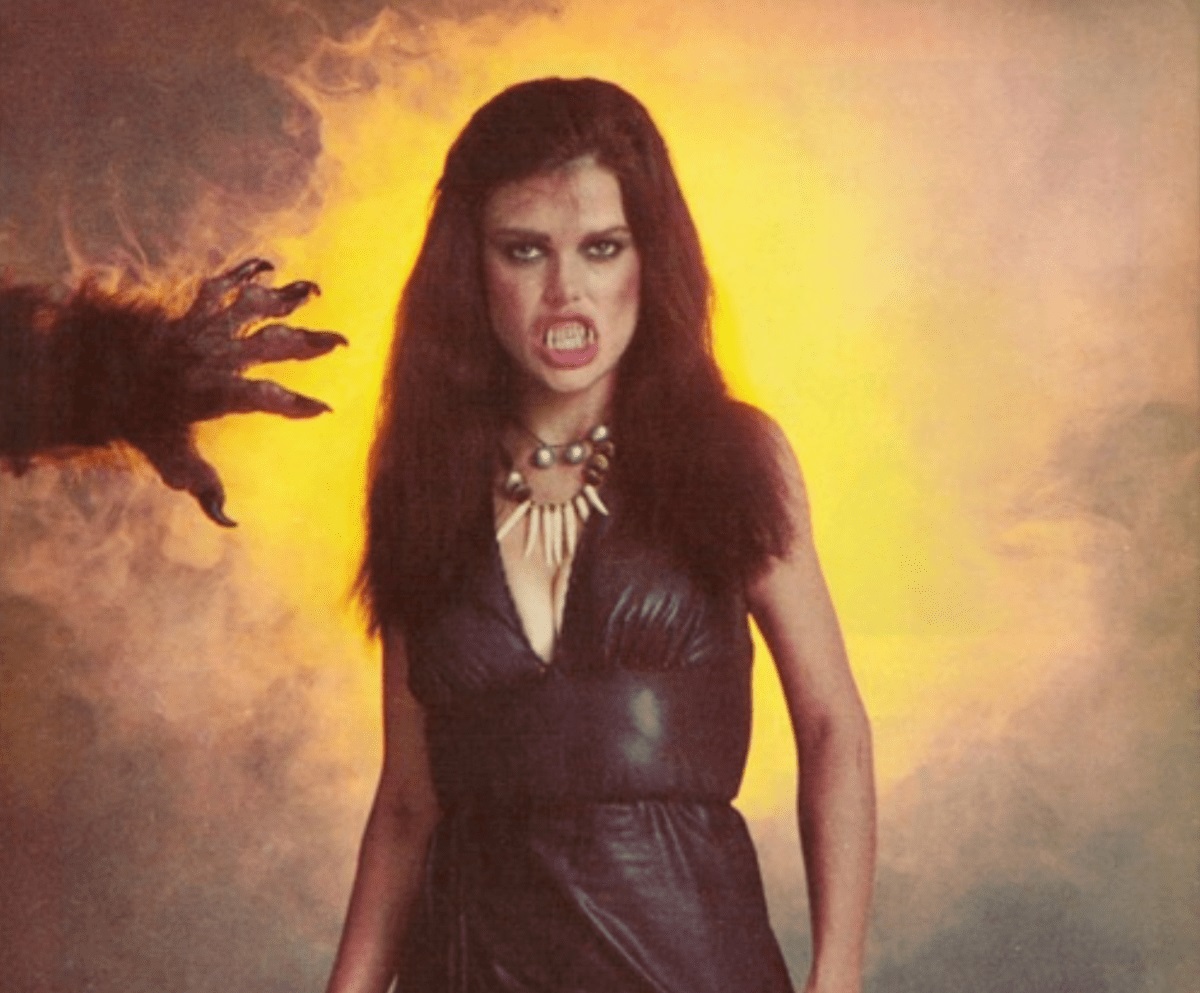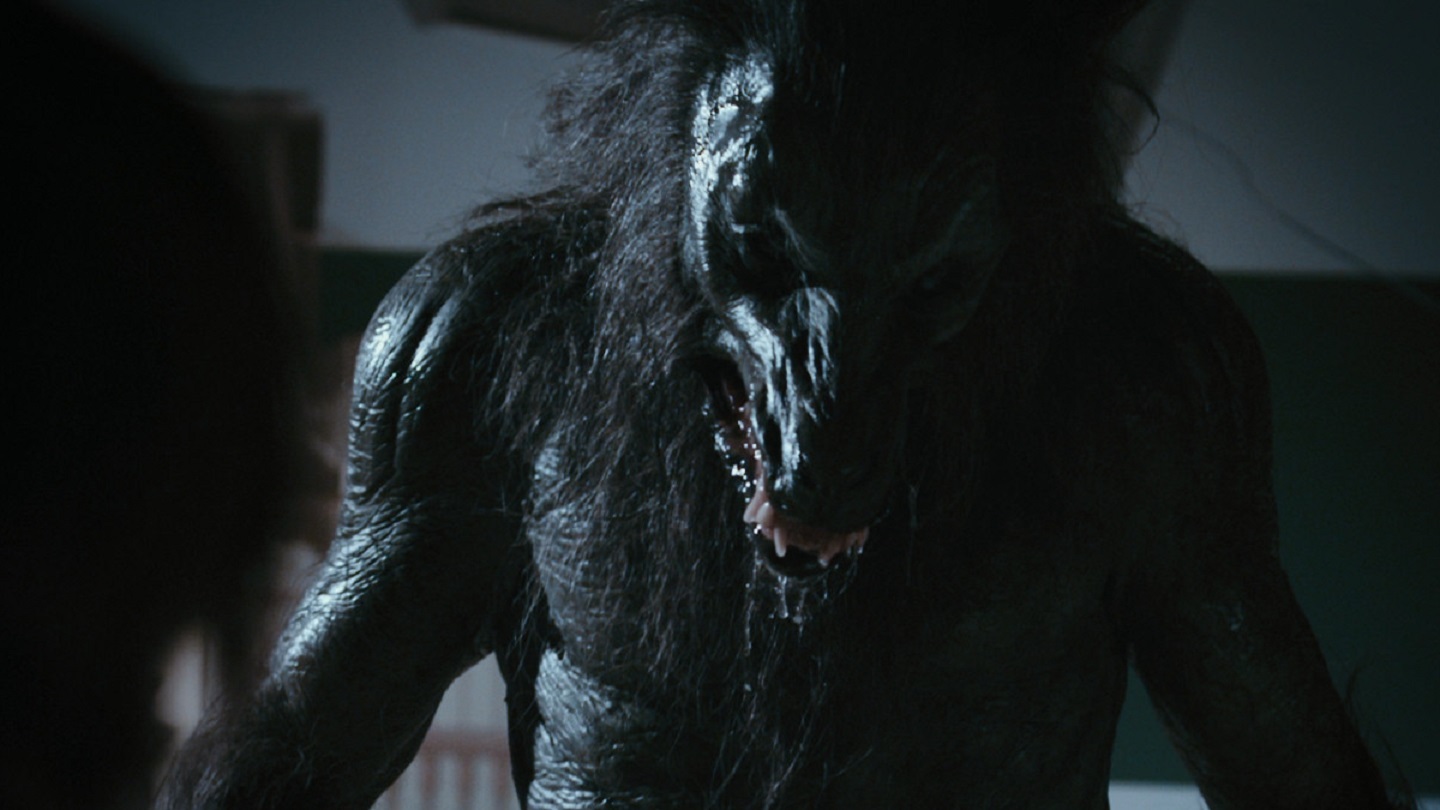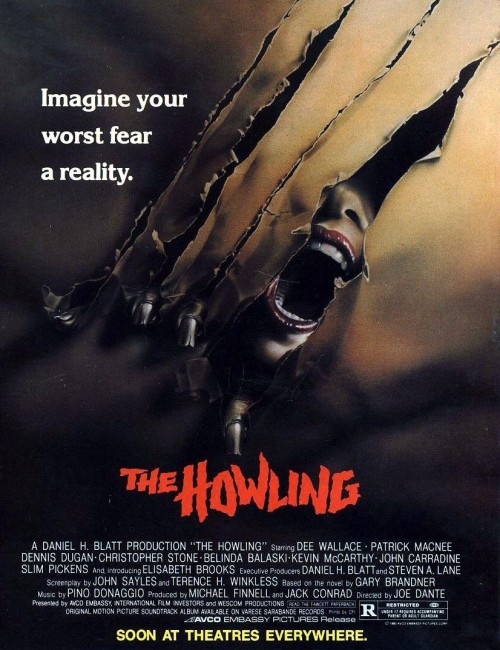USA. 1981.
Crew
Director – Joe Dante, Screenplay – John Sayles & Terence H. Winkless, Based on the Novel by Gary Brandner, Producers – Jack Conrad & Michael Finnell, Photography – John Hora, Music – Pino Donaggio, Animation – Visual Concept Engineering (Supervisor – Peter Kuran), Stop Motion Animation – David Allen, Special Effects – Roger George, Mechanical Effects – Doug Beswick, Makeup Effects – Rob Bottin, Makeup Effects Consultant – Rick Baker, Art Direction – Robert A. Burns. Production Company – Avco Embassy/International Film Investors/Wescom Productions.
Cast
Dee Wallace (Karen White), Christopher Stone (R. William Neill), Patrick MacNee (Dr George Waggner), Dennis Dugan (Chris Halloran), Belinda Balaksi (Terry Fisher), Elisabeth Brooks (Marsha Quist), John Carradine (Erle Kenton), Kevin McCarthy (Fred Francis), Robert Picardo (Eddie Quist), Dick Miller (Walter Paisley), Slim Pickens (Sheriff Sam Newfield), Don McLeod (T.C. Quist), Margie Impert (Donna Barton), Noble Willingham (Charlie Barton)
Plot
TV news anchorwoman Karen Stone agrees to conduct an interview with Eddie Quist who claims to be a wanted killer. He insists on meeting in the private booth of a porn store. When Karen goes in, he reveals himself to her and she screams, whereupon the police waiting outside shoot him. Afterwards, Karen suffers a memory blackout and is unable to remember what happened. On the advice of her psychologist Dr George Waggner, she and her husband Bill go to recuperate at The Colony, a therapeutic commune that Waggner runs on the Californian coast. What they are not aware is that The Colony is in fact a retreat for werewolves. As Karen’s recovery places strain on their marriage, Bill is tempted away by a werewolf woman and then transformed into one of their kind.
In the early 1980s, Joe Dante emerged as a director with several quirky low-budget films before moving onto A-budget films, most famously Gremlins (1984). He had previously worked for Roger Corman’s New World Pictures, cutting trailers and then co-directing Hollywood Boulevard (1976), a spoof film that was very much an expose of life in the Corman studios, and then Piranha (1978), one of the most amusing of the Jaws (1975) copies of the era. (See below for Joe Dante’s other films). Throughout these, Dante revealed himself as a director steeped in genre fandom – his films are playful and come stocked with in-jokes, parodies, references and actors from B movies of the 1950s. Indeed, these gags became so much so that the in-jokes tended to overtake some of his later films. The Howling was the film where attention first started to gather around Dante’s name.
The Howling came out after a decade in which science-fiction and horror cinema started to loosen the shackles. The monster shows that had dominated 1930s and 40s cinema were being treated less than seriously in efforts like Schlock (1973), The Phantom of the Paradise (1974), Young Frankenstein (1974) and The Rocky Horror Picture Show (1975), while science-fiction’s stalwart heroes started to lose their innocence and have the seriousness knocked out of their sails in efforts like tv’s Batman (1966-8) and films like Barbarella (1968) and Flesh Gordon (1974). For science-fiction, it was Star Wars (1977); for the horror genre, it was The Howling. These two can be seen almost as a demarcation line where science-fiction and horror cinema made the move over into post-modern genres where the films were now being made by directors who had grown up watching the classics on television. Not only was it a second generation building on the backs of their predecessors and improving what inspired them but also filmmakers that started paying tribute to their inspirations, quoting from and spoofing the originals. In other words, what we have is a line where we go from straightforward dramas to films that take place in a world where the history of the genre has played a real part and where you often had to be as steeped in its history to be in on the private fan joke that was taking place on screen.
Joe Dante grew up contributing articles to the seminal fanboy mag Famous Monsters of Filmland (1958-82). His films come jam-packed with genre in-jokes and cameos from actors and directors. The Howling, for instance, features cameos from 1950s genre actors such as Kevin McCarthy, the star of Invasion of the Body Snatchers (1956); genre veteran John Carradine giving maybe his last ever decent performance; Kenneth Tobey, the star of The Thing from Another World (1951); Dante’s mentor, the legendary 1950s B movie director/producer Roger Corman who can be seen standing outside a phone booth; Famous Monsters editor Forrest J. Ackerman who is seen holding copies of the magazine as her peruses a second-hand bookstore; and actor Dick Miller, credited as his A Bucket of Blood (1959) character Walter Paisley (a gag that Miller would repeat in subsequent Dante films), who plays the bookstore owner. (Indeed, Joe Dante single-handedly revived the career of Miller who then became used by other filmmakers as a kind of shared joke/good luck charm).

Indeed, The Howling is less a werewolf film than it is a film of werewolf movie in-jokes. The characters are named after werewolf movie directors – George Waggner, director of the Lon Chaney Jr The Wolf Man (1941), which created the essential tropes of the werewolf genre on film; Roy William Neill, director of Frankenstein Meets the Wolf Man (1943); Terry (or Terence) Fisher, director of Hammer’s Curse of the Werewolf (1961); Fred (or Freddie) Francis, director of Legend of the Werewolf (1974); Erle Kenton, director of House of Frankenstein (1944), a monster bash that featured Lon Chaney Jr’s Wolf Man; Sam Newfield, director of The Mad Monster (1942); Jerry Warren, director of Face of the Screaming Werewolf (1964); Lew Landers, director of Return of the Vampire (1944), which also contained a werewolf; and Charlie (Charles) Barton, director of Abbott and Costello Meet Frankenstein (1948), which featured Lon Chaney Jr’s Wolf Man, as well as Disney’s weredog film The Shaggy Dog (1959). The film is packed with throwaway gags featuring Big Bad Wolf cartoons, cards that spell out ‘wolf’, copies of Allan Ginsberg’s Howl (1956) and The Wolf Man playing on tv in the background and, most amusingly, moments like the tv station’s cutting to a dog food commercial after Dee Wallace’s on-air transformation. It was Joe Dante’s influence primarily that gave birth to an industry of deliberately bad science-fiction movies and an ongoing in-joke of littering the names of genre people and characters throughout films that other directors like Fred Olen Ray and Jim Wynorski made careers out of later in the decade.
The Howling is nominally based on a 1977 novel by Gary Brandner. The film is actually more interesting than the book chiefly through having little to do with it – the film keeps the basic set up of the heroine with the memory blackout and her and her husband going to stay in the countryside where he is tempted astray by a werewolf woman before they make the discovery that everyone around them is a werewolf too. The film has added the jokey tone, the psychologist character and the commune, and rewritten the heroine from a housewife to a tv news presenter. Brandner also wrote two sequels to his book with The Howling II/Return of the Howling (1979) and The Howling III: Echoes (1985).
Without the jokes, The Howling would otherwise be a competent B film – but for one scene. It was a scene that made audiences at the time sit up and pay attention and turned The Howling into a cult film – this being the scene in the middle of the film where Robert Picardo transforms into a werewolf. It is a show-stopping set-piece that for once and all put the old Lon Chaney-type lap dissolves into their grave. Makeup effects artist Rob Bottin provides an arsenal of air-bladder effects that allow jaws and fangs to extend out, shirts to rip a la The Incredible Hulk (1977-81), eyes to change and ears, claws, fur and feral teeth to grow out in real-time, all accompanied by some wonderful popping sound effects. It is a dazzling showstopper of a set-piece. The Howling, along with An American Werewolf in London (1981) the following year, gave birth to a new breed of horror film that focused on these air-bladder transformation effects. This fad included the likes of The Beast Within (1982), Cat People (1982), Conan the Barbarian (1982), The Thing (1982), The Company of Wolves (1984), Fright Night (1985) and The Blob (1988), before CGI transformation effects came to supplant these (much for the lesser, I would add – there has yet to be a standout CGI transformation sequence). I would go so far as to say that The Howling holds the best werewolf effects of any film to date – Rob Bottin’s shot of a full body werewolf standing up in the office is magnificent.

The Howling is one of the most outrightly enjoyable of Joe Dante’s films. Here the jokes are fresh and the routine story is elevated by the effects set-pieces and Dante’s quirky approach. Dick Miller gets into the spirit of the film and gives an hilarious motormouth performance. One of the memories permanently imprinted on my teenage hormones is a sizzling sequence where the luscious Elisabeth Brooks strips off and seduces Christopher Stone in the woods, transforming into a werewolf in mid-embrace.
The Howling gave impetus to a number of careers – Dee Wallace next went on to play the Mom on E.T. – The Extra-Terrestrial (1982) and roles in other films like Cujo (1983), Critters (1986) and The Frighteners (1996), among numerous other genre efforts both A and B-budgeted. She also married Christopher Stone who played her husband in this film, although he died in 1995. Robert Picardo made his acting debut here and went on to play in most of Joe Dante’s subsequent films, before his most famous role as the holographic doctor on Star Trek: Voyager (1995-2001). Despite making a memorable appearance here, Elizabeth Brooks failed to go onto any career as a B-movie queen that she eminently could have and died in 1997 after only a handful of other film roles.
The script comes from John Sayles, who wrote Joe Dante’s Piranha, and would write scripts for several other B-budget films during this era including The Lady in Red (1979), Alligator (1980) and Battle Beyond the Stars (1980), as well as subsequent A-budget films such as Clan of the Cave Bear (1986) and The Spiderwick Chronicles (2008). Sayles had made his directorial debut with Return of the Seacaucus Seven (1979) and went on to become an eminent independent director/writer with the likes of Lianna (1983), Baby It’s You (1982), The Brother from Another Planet (1984), Matewan (1987), The Secret of Roan Inish (1994), Lone Star (1996), Men with Guns (1997), Limbo (1999), Sunshine State (2002), Case de los Babys (2003), Silver City (2004), Honeydripper (2007), Amigo (2010) and Go For Sisters (2013). (Sayles can also be spotted in a small role in the film as a coroner). The only other works adapted from the works of Gary Brandner have been the horror film Cameron’s Closet (1988) and the tv mini-series From the Dead of Night (1989).
Joe Dante’s subsequent films were:– the third episode of the anthology Twilight Zone – The Movie (1983); the huge hit of Gremlins (1984); Explorers (1985) about teenagers discovering a mean of space travel; Innerspace (1987), a parody of Fantastic Voyage (1966); segments of the comedy skit anthology Amazon Women on the Moon (1987); the suburban paranoia black comedy The ‘Burbs (1989); Gremlins 2: The New Batch (1990); Matinee (1993) about a genre fan’s childhood; the toy wars film Small Soldiers (1998); the toon adventure Looney Tunes: Back in Action (2003); the Young Adult horror film The Hole (2009); Burying the Ex (2014) about a zombie ex-girlfriend; and the Mirari episode of the horror anthology Nightmare Cinema (2018). Dante also created the delightful smalltown paranoia tv series Eerie Indiana (1991-2) and produced the short-lived The Osiris Chronicles (1998), as well as the film adaptation of the comic-book legend The Phantom (1996).
The Howling was followed by a number of sequels:– The Howling II/The Howling II: Stirba – Werewolf Bitch (1985), The Marsupials: The Howling III (1987), Howling IV: The Original Nightmare (1988), The Howling V: The Rebirth (1989), Howling VI: The Freaks (1991), Howling: New Moon Rising (1995) and The Howling Reborn (2011). Only the first sequel is even remotely connected to this continuity-wise, although the others make claim to be based on Gary Brandner’s books. In all of these, Joe Dante’s jokey style has been abandoned and the focus is on (cheap) transformation effects. All of the sequels are terrible.
Trailer here

